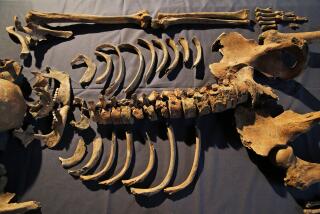Researcher Suggests Ebola May Be to Blame for Ancient Athens Plague
- Share via
The plague struck a city at war, crowded with livestock and refugees.
It began with a fever. The victims’ eyes turned bloodshot, and their mouths and tongues began to bleed. There was coughing, vomiting, violent retching. There were sores, a burning sensation and diarrhea.
And everywhere, there was death.
The plague devastated the city’s military forces and robbed it of an effective general. It may have prolonged a war that changed the course of history.
But, 2,500 years later, scholars still can’t say what affliction struck Athens in the summer of 430 B.C.
The best account of the plague, written on the scene by the Athenian general and historian Thucydides, tantalizes with its vivid descriptions and frustrates with its incompleteness. Over the centuries, it has led researchers to propose dysentery, smallpox, measles, influenza, anthrax, typhus, bubonic plague and a host of other ailments as the plague’s cause.
“Theorizing about the plague of Athens has been a medical parlor game for many centuries,” says David Morens, a professor of tropical medicine at the University of Hawaii.
So far, it’s a game nobody has won. No theory fits all the symptoms described by Thucydides, or explains the deliberate way the ancient plague passed through the population.
The latest proposal--that the plague was caused by the deadly Ebola virus--is just as full of holes as any other. But its main proponent insists that his theory deserves special attention because, unlike most other ideas, it can be put to the test.
Capt. Patrick Olson, an epidemiologist at the Naval Medical Center in San Diego, has arranged for the remains of the Athenians who perished to be tested for traces of the Ebola virus.
Ebola has been making such frightening appearances lately that it’s no wonder somebody has tried to pin the Athenian plague on the disease, Morens says.
Ebola claims almost all of its victims, and quickly. Most people who get it are dead within two weeks. The virus has killed about 800 victims since 1976, almost all of them in central Africa.
In a recent letter to the journal Emerging Infectious Diseases, Olson and three colleagues cite some uncanny similarities between Thucydides’ ancient description of the plague and a report by the Centers for Disease Control and Prevention on a 1995 Ebola outbreak in Zaire.
“It just kind of triggered a resonance,” says Olson, who dreamed up the connection while reading the publication “Morbidity and Mortality Weekly Report.”
“It just seemed that I should go back and read Thucydides,” he says.
When he did, he saw remarkable parallels between the modern and ancient accounts. Fever, diarrhea and severe weakness all were prominent symptoms. In addition, both plagues were focused on a small geographic region and passed easily from patient to doctor.
And one symptom, which Thucydides described as “lugx kene” in ancient Greek, can be translated to mean “hiccups.” That’s a distinctive feature in many Ebola cases, Olson says.
During recent excavations for the Athens subway, workers digging through the ancient Kerameikos cemetery uncovered the remains of people who died during the plague 2,500 years ago.
At Olson’s request, a Greek pathologist has agreed to try recovering bone marrow from the remains and testing it for genetic material produced by the Ebola virus. Ebola also could be detected by using a microscope to search for the telltale structures the virus leaves as it ravages the body.
But even if the tests can be done, few people who have studied the Athenian plague believe the bones will indicate Ebola. Not only would Olson have to be right, but the evidence for Ebola would have to be intact after sitting in the ground for 2 1/2 millenniums.
“I think it’s a crazy idea,” says Thomas Worthen, a professor of classics at the University of Arizona. His favorite suspect is anthrax, a bacterial infection carried by cattle.
Morens, who has spent as much time as anybody studying the plague of Athens, doesn’t believe Ebola is the right answer either.
He’s seen explanations for the Athenian plague come and go, and he doesn’t think Ebola fits the facts any better than the popular explanation he shot down a few years ago--that a combination of influenza and toxic-shock syndrome could account for the epidemic.
The theory was that a flu epidemic could have made Athenians susceptible to a deadly bacterium like the one found to cause toxic-shock syndrome. But flu would have swept through Athens like wildfire, Morens notes, doing its damage in two months or less. That doesn’t fit with Thucydides’ account, which tells of the plague flaring up occasionally over a five-year period.
And neither does Ebola.
“You couldn’t make an Ebola epidemic last five years,” Morens says.
The newly discovered bones could prove Morens wrong, or they could show another disease caused the plague of Athens--perhaps even a disease that no longer exists.
But having worked in the dark for so long, most researchers doubt Olson’s analyses will tell them anything new--and are beginning to wonder whether studying the plague is anything more than an academic exercise.
“I’m unwilling to endorse any theory,” Morens says. “Probably we’ll never know what it really was.”






